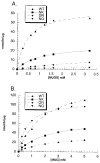Identification of the 6-sulfate binding site unique to alpha-subunit-containing isozymes of human beta-hexosaminidase
- PMID: 11331008
- PMCID: PMC2910086
- DOI: 10.1021/bi0029200
Identification of the 6-sulfate binding site unique to alpha-subunit-containing isozymes of human beta-hexosaminidase
Abstract
In humans, beta-hexosaminidase A (alphabeta) is required to hydrolyze GM2 ganglioside. A deficiency of either the alpha- or beta-subunit leads to a severe neurological disease, Tay-Sachs or Sandhoff disease, respectively. In mammals beta-hexosaminidase B (betabeta) and S (alphaalpha) are other major and minor isozymes. The primary structures of the alpha- and beta-subunits are 60% identical, but only the alpha-containing isozymes can efficiently hydrolyze beta-linked GlcNAc-6-SO(4) from natural or artificial substrates. Hexosaminidase has been grouped with glycosidases in family 20. A molecular model of the active site of the human hexosaminidase has been generated from the crystal structure of a family 20 bacterial chitobiase. We now use the chitobiase structure to identify residues close to the carbon-6 oxygen of NAG-A, the nonreducing beta-GlcNAc residue of its bound substrate. The chitobiase side chains in the best interactive positions align with alpha-Asn(423)Arg(424) and beta-Asp(453)Leu(454). The change in charge from positive in alpha to negative in beta is consistent with the lower K(m) of hexosaminidase S, and the much higher K(m) and lower pH optimum of hexosaminidase B, toward sulfated versus unsulfated substrates. In vitro mutagenesis, CHO cell expression, and kinetic analyses of an alphaArg(424)Lys hexosaminidase S detected little change in V(max) but a 2-fold increase in K(m) for the sulfated substrate. Its K(m) for the nonsulfated substrate was unaffected. When alphaAsn(423) was converted to Asp, again only the K(m) for the sulfated substrate was changed, increasing by 6-fold. Neutralization of the charge on alphaArg(424) by substituting Gln produced a hexosaminidase S with a K(m) decrease of 3-fold and a V(max) increased by 6-fold for the unsulfated substrate, parameters nearly identical to those of hexosaminidase B at pH 4.2. As well, for the sulfated substrate at pH 4.2 its K(m) was increased 9-fold and its V(max) decreased 1.5-fold, values very similar to those of hexosaminidase B obtained at pH 3.0, where its betaAsp(453) becomes protonated.
Figures





Similar articles
-
A single site in human beta-hexosaminidase A binds both 6-sulfate-groups on hexosamines and the sialic acid moiety of GM2 ganglioside.Biochim Biophys Acta. 2003 Jan 20;1637(1):113-8. doi: 10.1016/s0925-4439(02)00221-1. Biochim Biophys Acta. 2003. PMID: 12527415 Free PMC article.
-
Identification of an active acidic residue in the catalytic site of beta-hexosaminidase.Biochemistry. 1996 Jun 11;35(23):7599-607. doi: 10.1021/bi960246+. Biochemistry. 1996. PMID: 8652542
-
Identification of domains in human beta-hexosaminidase that determine substrate specificity.J Biol Chem. 1996 Jul 19;271(29):17377-82. doi: 10.1074/jbc.271.29.17377. J Biol Chem. 1996. PMID: 8663217
-
The biochemical genetics of the hexosaminidase system in man.Am J Hum Genet. 1979 Mar;31(2):95-105. Am J Hum Genet. 1979. PMID: 377957 Free PMC article. Review.
-
Isoenzymes of N-acetyl-beta-hexosaminidase.Acta Biochim Pol. 1999;46(3):739-51. Acta Biochim Pol. 1999. PMID: 10698282 Review.
Cited by
-
Lending a helping hand, screening chemical libraries for compounds that enhance beta-hexosaminidase A activity in GM2 gangliosidosis cells.FEBS J. 2007 Oct;274(19):4951-61. doi: 10.1111/j.1742-4658.2007.06040.x. FEBS J. 2007. PMID: 17894780 Free PMC article. Review.
-
A single site in human beta-hexosaminidase A binds both 6-sulfate-groups on hexosamines and the sialic acid moiety of GM2 ganglioside.Biochim Biophys Acta. 2003 Jan 20;1637(1):113-8. doi: 10.1016/s0925-4439(02)00221-1. Biochim Biophys Acta. 2003. PMID: 12527415 Free PMC article.
-
Increased phosphorylation of HexM improves lysosomal uptake and potential for managing GM2 gangliosidoses.BBA Adv. 2021 Dec 13;2:100032. doi: 10.1016/j.bbadva.2021.100032. eCollection 2022. BBA Adv. 2021. PMID: 37082581 Free PMC article.
-
A sensitive fluorescence-based assay for monitoring GM2 ganglioside hydrolysis in live patient cells and their lysates.Glycobiology. 2010 Mar;20(3):356-65. doi: 10.1093/glycob/cwp183. Epub 2009 Nov 16. Glycobiology. 2010. PMID: 19917668 Free PMC article.
-
Therapeutic potential of intracerebroventricular replacement of modified human β-hexosaminidase B for GM2 gangliosidosis.Mol Ther. 2011 Jun;19(6):1017-24. doi: 10.1038/mt.2011.27. Epub 2011 Apr 12. Mol Ther. 2011. PMID: 21487393 Free PMC article.
References
-
- O’Dowd BF, Klavins MH, Willard HF, Gravel R, Lowden JA, Mahuran DJ. J Biol Chem. 1986;261:12680–12685. - PubMed
-
- Mahuran DJ, Lowden JA. Can J Biochem. 1980;58:287–294. - PubMed
-
- Hou Y, Tse R, Mahuran DJ. Biochemistry. 1996;35:3963–3969. - PubMed
-
- Gravel RA, Clarke JTR, Kaback MM, Mahuran D, Sandhoff K, Suzuki K. In: The Metabolic and Molecular Bases of Inherited Disease. Scriver CR, Beaudet AL, Sly WS, Valle D, editors. McGraw-Hill; New York: 1995. pp. 2839–2879.
Publication types
MeSH terms
Substances
Grants and funding
LinkOut - more resources
Full Text Sources
Other Literature Sources
Research Materials
Miscellaneous

